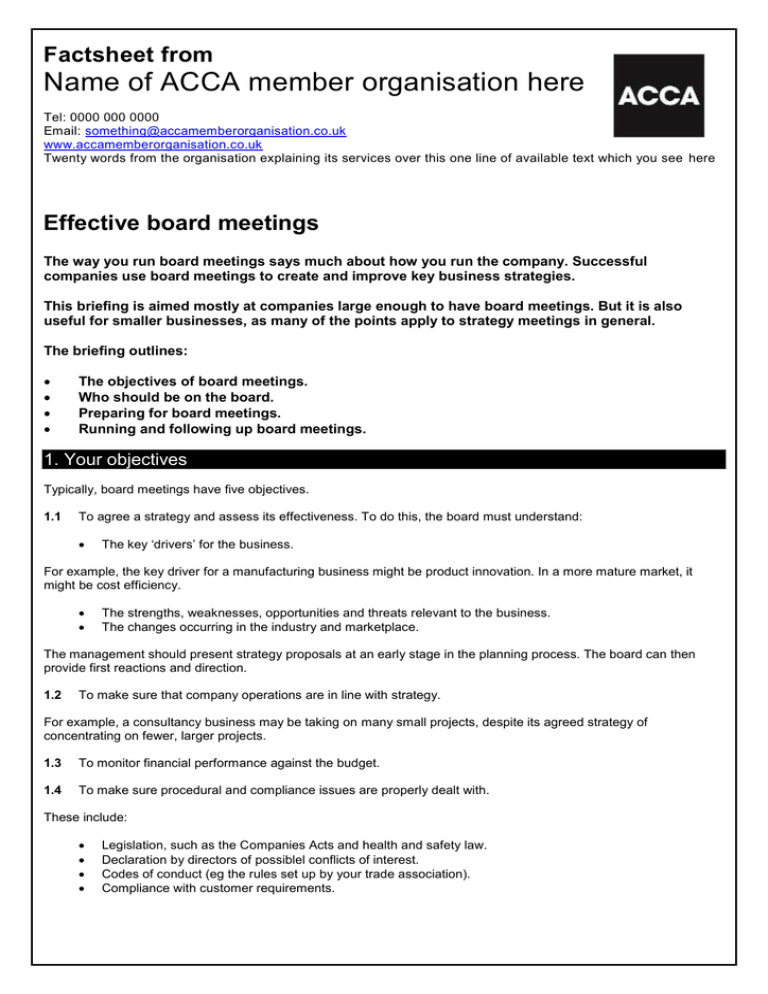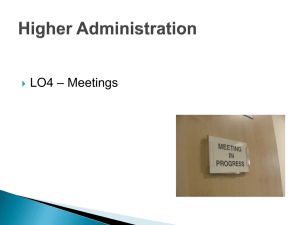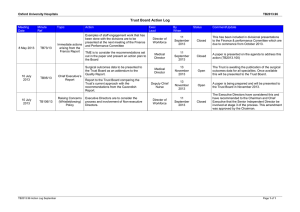
Factsheet from
Name of ACCA member organisation here
Tel: 0000 000 0000
Email: something@accamemberorganisation.co.uk
www.accamemberorganisation.co.uk
Twenty words from the organisation explaining its services over this one line of available text which you see here
Effective board meetings
The way you run board meetings says much about how you run the company. Successful
companies use board meetings to create and improve key business strategies.
This briefing is aimed mostly at companies large enough to have board meetings. But it is also
useful for smaller businesses, as many of the points apply to strategy meetings in general.
The briefing outlines:
The objectives of board meetings.
Who should be on the board.
Preparing for board meetings.
Running and following up board meetings.
1. Your objectives
Typically, board meetings have five objectives.
1.1
To agree a strategy and assess its effectiveness. To do this, the board must understand:
The key ‘drivers’ for the business.
For example, the key driver for a manufacturing business might be product innovation. In a more mature market, it
might be cost efficiency.
The strengths, weaknesses, opportunities and threats relevant to the business.
The changes occurring in the industry and marketplace.
The management should present strategy proposals at an early stage in the planning process. The board can then
provide first reactions and direction.
1.2
To make sure that company operations are in line with strategy.
For example, a consultancy business may be taking on many small projects, despite its agreed strategy of
concentrating on fewer, larger projects.
1.3
To monitor financial performance against the budget.
1.4
To make sure procedural and compliance issues are properly dealt with.
These include:
Legislation, such as the Companies Acts and health and safety law.
Declaration by directors of possiblel conflicts of interest.
Codes of conduct (eg the rules set up by your trade association).
Compliance with customer requirements.
1.5
To use non-executive directors as sounding boards for new ideas.
Take full advantage of non-executives as a source of alternative approaches to problems and opportunities.
(See 3.)
Done well, board meetings help a company to work out a business strategy and set it up successfully.
2. Members of the board
Choosing the right mix of people creates an effective board. Each board director’s role should be agreed in the first
place.
2.1
The choice of chairperson is crucial. While the managing director runs the company, it is the chairperson who
runs the board. All boards need strong leadership.
Appoint a chairperson who can:
Create a good team.
Command respect from fellow board members, shareholders and employees.
Understand the business.
Listen to all opinions and speak honestly.
2.2
Experienced non-executive directors can have a major positive impact (see 3).
2.3
A team with complementary skills contributes to sound decision-making.
For example, if you plan to expand, find someone who understands the financial implications.
Similarly, blend optimism with pessimism, and experience with youth.
2.4
Board members should be selected on merit. They need to be able to:
2.5
Think strategically, with a long-term view and a level-headed, realistic approach.
Work well with the rest of the board.
Contribute to discussions outside their main area of expertise.
Put the company’s best interests ahead of their personal best interests.
To be effective, the board should agree on the objectives and scope of the board meetings.
Ask each board member to write down his or her views.
Opinions will vary considerably, but you can then come to a workable agreement. This is the first step in getting the
board to work as a team.
Resist pressure to appoint unsuitable people to the board.
For example: the long-term manager, appointed as the only means of promotion; the chairperson’s friend, appointed as
a non-executive to strengthen the chairperson’s own position; or the shareholders’ representative, who has little
business experience.
3. Non-executive directors
Non-executive directors (‘non-execs’) can make a board considerably more effective, at a low annual cost.
3.1
Consider the role non-execs could play in your business.
For example, they can be particularly effective in:
2
3.2
Recruit non-execs who have the right characters.
3.3
The stronger the other personalities on the board, the stronger the non-execs’ characters need to be.
Non-execs should have no axe to grind and no fear of upsetting their board colleagues. They should give
their honest opinion of new ideas.
Use non-execs as agents of change.
3.4
Providing an independent overview of the business strategy.
Bringing in outside experience from other companies and industries.
Counteractring board weakness in a particular area.
Planning the succession of executive management for a business.
Without non-execs, there is a tendency to carry on doing the same things the same way, without looking at
alternatives.
Draw on non-execs’ experience and objectivity to help take tough decisions.
For example:
Closing down loss-making activities.
Laying off employees or asking a fellow director to resign.
Deciding emotional subjects like directors’ pay, share options, company car policy, and general payment
issues.
Managing the business through unexpected crises.
Appointing new auditors or directors.
Deciding whether to take legal proceedings on a particular issue.
It can be difficult for a single non-exec to win over a board. Ideally, there should be two or more.
4. Board papers
All board directors should come to the meeting well briefed. Distribute board papers on an agreed date before the
meeting.
Board papers should include several standard elements.
4.1
The agenda. A full agenda should:
Fit the agreed objectives of the board meetings (see 1).
Not be too long.
Have specific items to discuss, rather than just a list of general areas.
Include cross references to the relevant items in the board papers.
4.2
Minutes of the previous meeting.
4.3
Management accounts.
4.4
The board should invest considerable time in deciding which pieces of information are the most useful.
Papers relating to specific agenda items.
For example, a major equipment purchase.
A good summarising note helps the board to decide swiftly.
Generally speaking, the papers should not take much more than an hour to read and analyse.
3
Stick to an agreed format, so the papers are easy to use. Review the format once a year, as your focus will change
over time.
5. Running the meeting
5.1
The chairperson has the most influence on the meeting.
The chairperson’s role is to:
5.2
A good location for the meeting is important.
5.3
Decide on the final content of the agenda, together with the managing director.
Brief non-execs (and others) in advance on any sensitive issues.
Allocate time to agenda items according to their importance.
Create open discussions by introducing each item in a balanced, positive way.
Encourage the quieter directors to state their opinion and prevent anyone dominating the discussion.
Give views on each issue after the others have given theirs.
Summarise what has been decided, to check there are no misunderstandings.
Be firm in allocating responsibilities and making sure that they are carried out.
Check at the next meeting that all decisions have been put into practice.
An off-site venue can help you focus more on strategic issues and less on operational ones.
A good seating plan helps to draw everyone into the discussion.
The date of future meetings should be agreed in good time.
Larger companies generally have monthly meetings.
Smaller companies may find quarterly meetings more effective.
The effect of board meetings will be weakened if there are too many.
Limited companies must hold a board meeting if any director requests one or if more than 10 per cent of
members request one (this is reduced to 5 per cent of members if it has been more than one year since the
last board meeting).
This meeting is used to sign off the annual accounts and to approve any key decisions made by directors during the
year.
At times of rapid change, increase the number of meetings.
Board members should receive monthly management accounts, even when there is no board meeting.
6. Follow-up to the meeting
6.1
Keep the minutes of the meeting brief.
Minutes cover decisions made, actions agreed and responsibilities given.
They also include any statements which were specifically requested to be minuted.
6.2
Distribute the minutes promptly.
6.3
If appropriate, let employees (or others) know about any decisions made.
This is part of the action plan agreed in the meeting.
7. Improving your skills
A little training can make a big difference to the performance of a board.
4
7.1
Individual training needs analysis will reveal what is required.
Which directors understand the general duties and liabilities of a director?
Which directors carry out their role to the required standard?
Which directors lack experience?
One way to learn is to talk to the equivalent director in another company. Find out what lessons have been learnt by
this person, both individually and as a board.
7.2
Being a good chairperson demands skill.
The shortcomings of the chairperson are often overlooked, particularly if he or she is also the major
shareholder.
The chairperson should receive regular feedback on what could be improved.
Consider using a non-exec to carry out a regular appraisal. The non-exec can gather feedback from the whole board.
7.3
Non-execs should receive induction training.
Put together an information pack about the company’s operations. Set up meetings with the key
management.
Who is in charge?
The power of the board and its scope, usually depends on whether the main shareholders are involved in the day-today running of the business.
A business owned and managed by a single individual may prefer to use board meetings for compliance
purposes only. Everything else can be covered in management meetings, set up for the purpose in question
(eg strategy, monitoring). Non-executives may still be involved, but on a less formal basis.
A business owned by individuals (or organisations) with no daily involvement tends to rely heavily on the
board. Accountability to the board (and in turn to the shareholders) is a major issue. Non-executives may be
in charge of matters such as the audit, appointing new directors and wage policy.
A typical agenda
The agenda below shows a typical structure.
1.
Approval of the minutes of the last meeting.
2.
Matters arising.
3.
For example, this may include the appointment of a new director or the register of a share transfer.
Finance director’s report.
5.
Members are invited to raise issues which are not due to be covered in the published agenda.
Procedural and compliance issues.
4.
This is a chance for board members to note errors or to add points which have been left out.
This is a review of the company’s financial performance.
Managing director’s report.
5
This covers major new initiatives, the business outlook — including the order book — and foreseeable
threats and opportunities.
It includes a review of ongoing projects and operational issues.
6.
Strategic issues.
For example, the acquisition of another company or the creation of a new company department.
7.
Any other business.
8.
Date of next meeting.
Experts’ quotes
“Getting the right non-executive director is the world’s fastest shortcut to creating effective board meetings.”
Cobalt Corporate Finance
“The most useful word in a board meeting is ‘Why?’.”
Interflora
“Board effectiveness can be ruined by political in-fighting. Executives at board level have to stand above their own
functional interests and focus on company objectives.”
Anglo Recycling Technology Ltd.
Expert contributors
Thanks to Cobalt Corporate Finance LLP, 020 7491 1271, www.cobaltcf.com; BDO LLP , 020 7486 5888,
www.bdo.co.uk.
Last updated 01.10.11
© Atom Content Marketing 2011. ISSN 1369-1996. All rights reserved. No part of this publication may be reproduced or transmitted without the
written permission of the publisher. This publication is for general guidance only. The publisher, expert contributors and distributor disclaim all liability
for any errors or omissions. Consult your local business support organisation or your professional adviser for help and advice.
6



